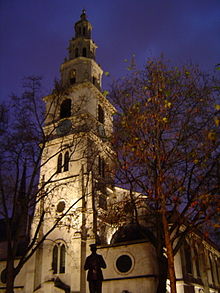St. Clement Danes
| St. Clement Danes | |
|---|---|

St. Clement Danes at night
|
|
| Location | City of Westminster, London |
| Country | United Kingdom |
| Denomination | Church of England |
| Churchmanship | Modern Catholic |
| Website | raf |
| Architecture | |
| Heritage designation | Grade I |
| Architect(s) | Christopher Wren |
| Style | Baroque |
| Years built | several, most recently 1682 |
| Administration | |
| Diocese | Diocese of London |
| Clergy | |
| Chaplain(s) | The Revd David Osborn |
| Laity | |
| Director of music | Simon Over |
| Business manager | Sharon Hardwick |
St Clement Danes is an Anglican church in the City of Westminster, London. It is situated outside the Royal Courts of Justice on the Strand. Although the first church on the site was reputedly founded in the 9th century by the Danes, the current building was completed in 1682 by Sir Christopher Wren. Wren's building was gutted during the Blitz and not restored until 1958, when it was adapted to its current function as the central church of the Royal Air Force.
The church is sometimes claimed to be the one featured in the nursery rhyme Oranges and Lemons and the bells do indeed play that tune. However, St Clement Eastcheap, in the City of London, also claims to be the church from the rhyme. St Clement Danes is known as one of the two 'Island Churches', the other being St Mary-le-Strand.
There are several possible theories as to the connection between the Danes and the origins of the church. A popular theory is that in the 9th century the Danes colonized the village of Aldwych on the river between the City of London and the future site of Westminster. This was at a time when half of England was Danish and London was on the dividing line between the English and the Danes. At Aldwych the Danes founded a church, hence the final part of its name. (in Latin it was known as Ecclesia Clementes Danorum). Alternatively, after Alfred the Great had driven the Danes out of the City of London and they had been required to accept Christianity, Alfred stipulated the building of the church. In either case, being a seafaring people, the Danes named the church they built after St Clement, patron saint of mariners.
...
Wikipedia
